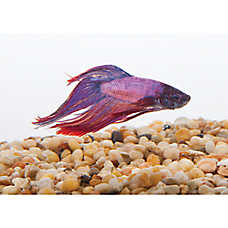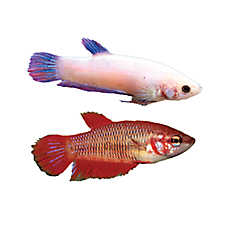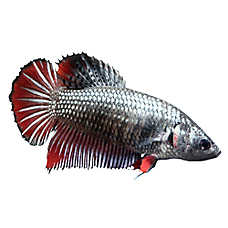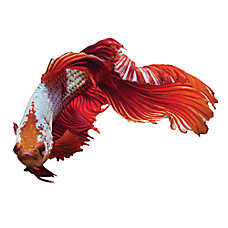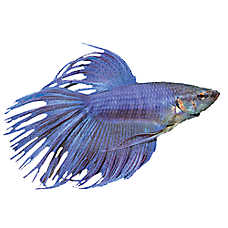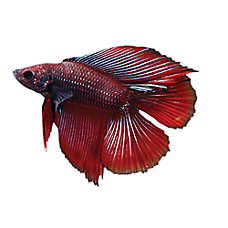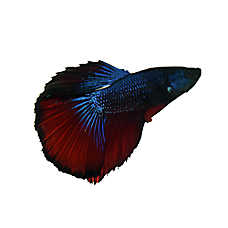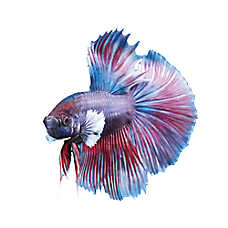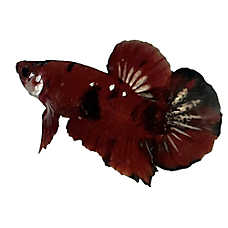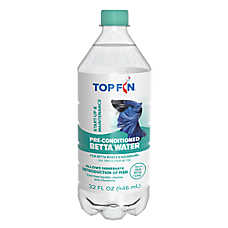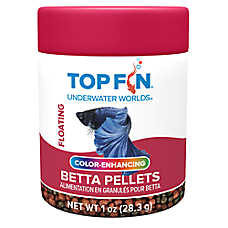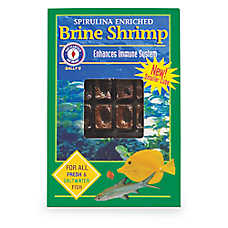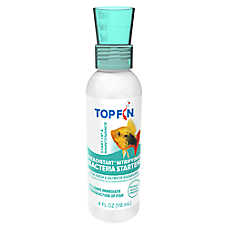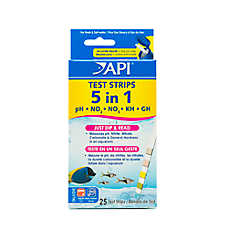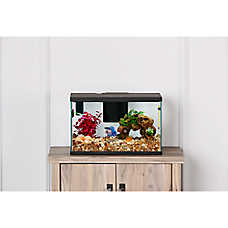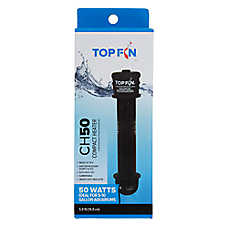Betta Care Guide
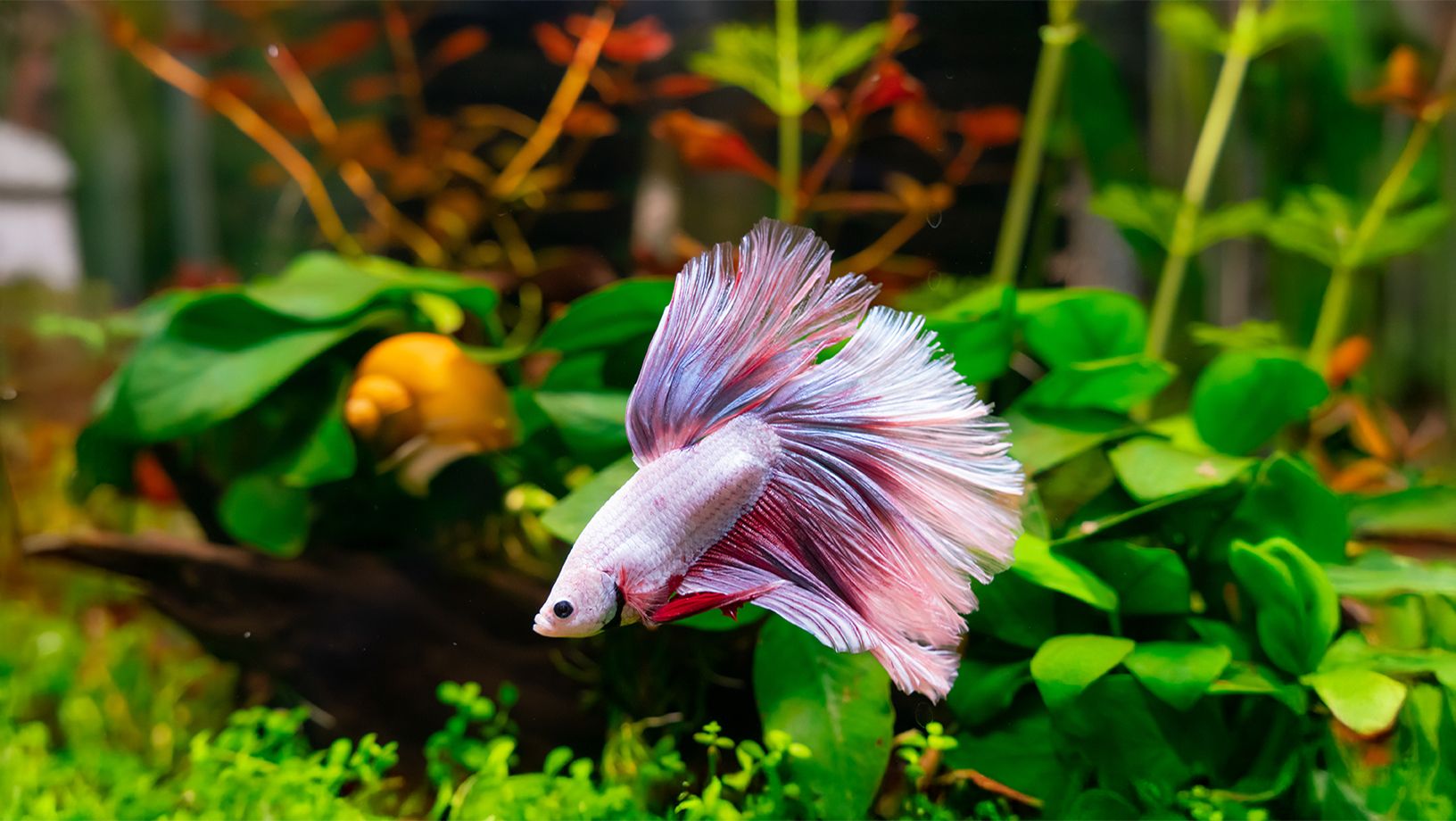
In this Article
Beautiful & Interactive
Bettas are colorful fish with flowing fins and fun personalities. They are so intelligent that they recognize the people who care for them. Some bettas can even do tricks!
While male bettas do not tolerate other male bettas, they can make a stunning addition to a community tank. Experienced fish keepers may find keeping female bettas in a sorority of 6 or more females in an aquarium is a gorgeous and rewarding experience.
Bettas often bond closely to their owners. A betta’s favorite past time is often laying on a hammock of leaves from a live plant or decoration but they’ll quickly swim right up if they think food is on the way!
Contrary to popular belief, bettas need a heated and filtered tank of at least 3 gallons, although they will be even happier in larger tanks. A 10 gallon tank is easier to maintain and a happier home for your betta! Bettas love the space of large tanks to explore and interact with their environments.
Behavior: When keeping fish as pets, there are no guarantees that the fish will get along. You should always monitor your fish for signs of stress or aggression and be prepared to move the fish from the aquarium. While many bettas do well in a community environment, some may be more aggressive or other fish may be quite aggressive to your betta! Always be prepared to move a fish if needed. Not sure which species get along? Our Fish Compatibility Guide can help you choose compatible tank mates.
It can also be helpful to rearrange/add décor to create more territories and hiding places. Live plants help maintain water quality and provide hiding places for fish. Often, the more plants and décor, the more you see your fish! A tank with lots of variety in plants and décor is more interesting and less stressful for your fish, a bit like offering new toys or beds to your dog or cat!
Facts About Betta Fish
SIZE: Up to 3”
LIFESPAN: 2-3 years, potentially longer in ideal conditions
EXAMPLES: Halfmoon, Dragonscale, Dumbo, Veiltail, Crowntail. All fancy bettas are Betta splendens crosses
TANK SIZE: 3+ gallon
HABITAT: Natural sand or gravel substrate and décor. Lots of live or artificial plants are preferred.
BEHAVIOR: Males tend to be more aggressive and can be quite territorial. While females may also show these behaviors, it’s less common.
SCHOOLING: No. Bettas are not schooling fish and generally prefer to be the only betta in your aquarium, especially males.
COMMUNITY: Bettas can be a great addition to a peaceful community tank. Other fish may nip their long and flowing fins so monitor for aggression towards your betta from other fish. Some bettas may exhibit aggression towards other fish so monitor your fish regularly.
NATURAL DIET: Small insects and crustaceans.
FOOD: High quality floating pellets or flakes and frozen fish food 2-3 times per week. Bettas are charming and it can be tempting to overfeed them. Maintaining a healthy diet, however, is very important.
Water Parameters | Ideal Betta Range |
Temperature | 72-76°F (25-28° C) |
Ammonia | 0ppm (mg/L) |
Nitrite | 0ppm (mg/L) |
Nitrate | Less than 20ppm |
pH | 6.0-8.0 |
Chlorine | 0ppm (mg/L) |
Alkalinity | 18-268ppm |
Typical Betta Fish Aquarium Setup
Essential Supplies:
- Glass or acrylic tank (minimum 3 gallons—larger is better for stability and enrichment)
- Aquarium hood or tank cover with light
- Aquarium heater and thermometer
- Substrate: Gravel or sand
- Décor for hiding and enrichment
- Live or artificial plants
Filter sized for your tank (See Aquarium Maintenance for more information on filtration)
Setup Tips:
- Place your tank on a flat, stable surface that can support the full weight (water weighs 8.3 lbs per gallon).
- Rinse substrate and décor thoroughly with tap water - never use soap.
- Add substrate and arrange decorations and plants.
- Fill the tank with tap water and add a water conditioner or dechlorinator.
- Connect heater, filter, and thermometer per manufacturer instructions.
- Bettas thrive in warm water—ensure the temperature is stable before adding fish.
- Install lights and use a timer to maintain a consistent day/night cycle (about 12 hours of light).
- Allow the tank to run for 24 hours. Confirm equipment is functioning and temperature is stable before adding fish or plants.
Before Adding Fish:
- Add a beneficial bacteria starter to help establish your nitrogen cycle.
- Monitor water quality daily during cycling. Perform water changes if:
- Ammonia or Nitrite > 0 ppm
- Nitrate > 20 ppm
- Learn more about fishless cycling(cycling is stressful and potentially harmful for bettas).
Once Established:
- Quarantine any new fish for 30 days in a separate, cycled aquarium to prevent disease.
When should I test my water quality?
- Fish are sluggish, near the bottom of the tank
- Fish are at the top, breaking the water to breathe
- Fish are not eating
- Sudden behavior changes in your fish
- Water is cloudy
- Water smells funny
PetSmart offers free water quality testing and one of our knowledgeable associates can help you get your system balanced.
When should I contact a veterinarian?
- Contact an aquatic veterinarian if you notice the following signs:
- Unusual swimming pattern
- Thinness or decreased appetite
- Abdominal swelling
- Inflamed or discolored skin/fins
- Fins clamped to sides of body
- Scraping body on rocks (flashing)
- Visible signs of illness or recent fish loss
If your fish show any of the signs above, we recommend using the “Find a Fish Vet” tool at fishvets.org or wavma.org to locate a qualified aquatic veterinarian in your area.
SHOPPING CHECKLIST
What will I need for my betta?
- Aquarium sized appropriately for the species and number of fish
- At least 3 gallons, although tanks 10 gallons and larger are easier to maintain
- Aquarium top/hood with light fixture
- Aquarium gravel or sand & gravel vacuum
- Tank décor like driftwood or ornaments
- Live or artificial plants
- Aquarium heater and thermometer
- Aquarium filter sized for your tank
- Water testing kit or strips
- Water conditioner/dechlorinator
- Beneficial bacteria starter
- Algae cleaning pad or scraper
- Species-appropriate pellets or flakes and frozen fish food
Ready to learn more?
This guide is a great starting place, but we encourage you to do more research on the individual species that you are keeping so that you can be as successful as possible with your aquarium!
Shop Standard Betta Fish
Classic fin shapes and colors that have been in the hobby for many years.
Shop Deluxe Betta Fish
Deluxe bettas have more variation in fin length and color.
Shop Premium Betta Fish
Premium bettas have beautiful long-flowing fins and the most vibrant colors
